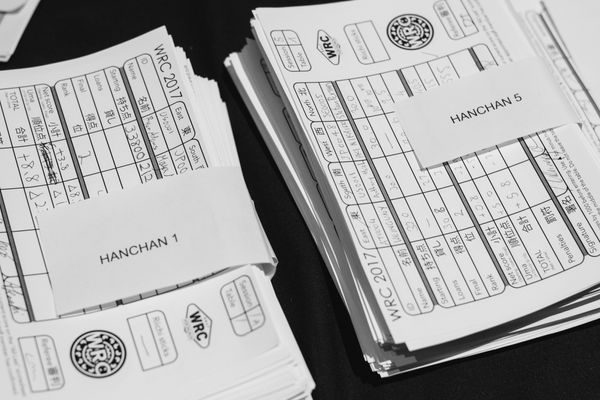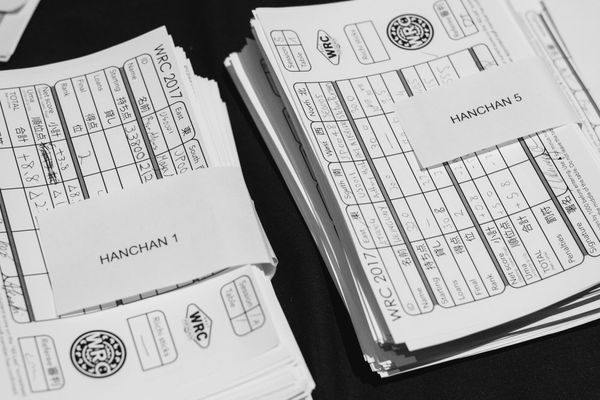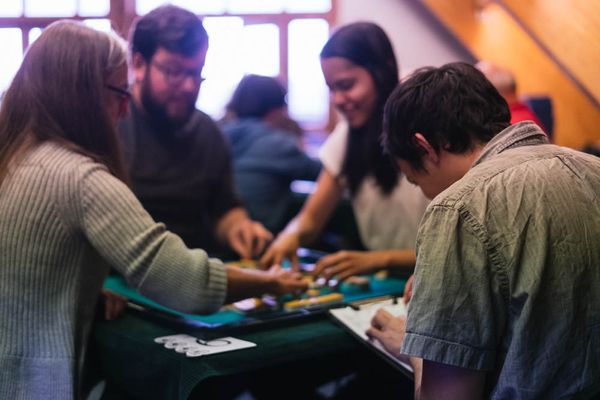Tsuchida Koushou Homage
As there are no posts for april yet, I thought I would write one, and I'd like to write about professional mahjong player Tsuchida Koushou (土田浩翔). This post will be about him.
Source of the information is the Japanese Wikipedia.
Tsuchida Koushou (土田浩翔) was born as "Tsuchida Kouji" (土田興司) in August 5th 1959, in Osaka. He graduated from the Otaru University of Commerce, and rose above the mahjong world with TV appearances (Mondo 21 and Gamble Taitei), publishing books, writing columns, appearing and winning at tournaments, as a special guest in many mahjong related events, as a character in Mahjong Fight Club video-games, and as the former chairman of the Japanese Mahjong Organization (日本麻雀機構). He is also the manager of the mahjong parlor in Sapporo called 夢道場 ("Dojo Dream"). His bloodtype is B. He is also known as the "Toitsu Oukoku no Ouji" ("Prince of the kingdom of Pairs") and "Toitsu Master" as his mahjong style aims to make skillful usage of pairs (toitsu) as the ultimate attack technique. He developed a system called "Tsuchida System" as an attempt to explain toitsu theory, and how to better use them and stack them. Because of his mahjong style, he could be considered an occult player, but he still claims there is a digital background to his theories as well. Because of health reasons, he stopped activities on the Japanese Mahjong Organization, but returned to the mahjong world some time later and is currently a member of the 日本プロ麻雀協会 (Japanese Professional Mahjong Association).
Titles:
- Phoenix Tournament, 11th and 22th seasons. (プロリーグリーグ鳳凰位 第11期、第22期)
- King Tournament, 26th season. (王位戦 第26期)
- Strongest Rank, 9th season. (最強位 第9期)
- 10th Dan, 22th and 23th seasons. (十段位 第22期、第23期)
- Professional Grand Prix, 2nd season. (プログランプリ 第2回)
- Mondo 21 Cup, 3rd, 7th and 8th seasons. (モンド21杯 第3回、第7回、第8回)
- Mondo 21 King's Throne Finals, 4th season. (モンド21 王座決定戦 第4回)
He picked up mahjong when he was a 1st year student in elementary school. He won the 「ニッカン・アマ最高位戦」 (Japan-Korea Amateur Number One Tournament) right before graduating university, and as a result decided to become a professional.
- 1986, August. He successfully passes the 日本プロ麻雀連盟 (Japan Professional Mahjong League) professional test.
- 1990. In only four years, he rose to the association's top league, the A League, and became the runner up for the whole league and at the same time 鳳凰戦 (Phoenix Tournament).
- 1991. He changes his name from Tsuchida Kouji to Tsuchida Koushou.*
- 1992. He wins the second Professional Grand Prix (2回プログランプリ) and thusly receives his first title.
- 1996. He opens the "Yume Dojo" mahjong parlor in Sapporo.
- 2006. He graduates from the Japanese Professional Mahjong League, and establishes the Japanese Mahjong Organization (日本麻雀機構).
- 2007. He joins the RMU, a mahjong association established that year.
- 2010. He graduates from RMU, and continues representing the Japanese Mahjong Organization as a professional.
- 2010. Due to health reasons, he announces in the website of the Japanese Mahjong Organization that all activities are cancelled.
- 2011. He joins the 最高位戦日本プロ麻雀協会 (Japanese Professional Mahjong Association).
Publications:
<土田システム 麻雀が強くなるトイツ理論
(2005年 毎日コミュニケーションズ) (“Toitsu Theory to Become Strong at Mahjong”) Code: ISBN-10: 4839917019 ISBN-13: 978-4839917012
最強麻雀 土田システム (マイコミ麻雀BOOKS)
(2007年 毎日コミュニケーションズ) (“Strongest Mahjong Tsuchida System”) Code: ISBN-
10: 4839926565 ISBN-13: 978-4839926564
マイコミ麻雀文庫 土田システム 麻雀が強くなるトイツ理論
(2009年、加筆・文庫化 毎日コミュニケーションズ) (“Toitsu Theory to Become Strong at Mahjong” Edited, Paper-back version) Code: SBN-10: 4839932638 ISBN-13: 978-4839932633
マイコミ麻雀BOOKS 土田流麻雀 仕掛けを極める
(2010年2月24日、毎日コミュニケーションズ) (“Tsuchida Style Mahjong, Master Open Hands”) Code: ISBN-10: 4839934428 ISBN-13: 978-4839934422
Tsuchida's Play Style:
Toitsu System:
Its first characteristic is giving toitsu (a pair of identical tiles) serious importance, and it professes that "If you have 2 toitsu, consider the possibility of Chii Toitsu ("Seven Pairs"). Tsuchida says that the origin for that is a fondness for tanki waits (pair waits) and "the thrill of saying 'I am the one who can decide the future and what will happen!' as your 3-away from tenpai hand starts progressing".
Tsuchida says that the basic yaku (hand) that you should aim to complete is pinfu (peace) and states the following:
"If you always, always try to complete pinfu every hand, your mahjong becomes poor and dull, that is a reality. When your luck starts to decline, it becomes very difficult to complete pinfu, and anyone who plays the game a little knows that at those times a lot of toitsu and koutsu (three identical tiles) start coming to you by force. And nonetheless, if you reach tenpai you unfortunately decide on a 'ryanmen wait' (open-ended wait). It is not strange to me."
—Tsuchida Koushou ("Toitsu Theory to Become Strong at Mahjong" (year 2005 Mainichi Comunications) from page 152)
Reason for its creation
According to Tsuchida, the reason why he awakened and this system was born, was because of the events in a game where his luck was being really bad, and his hand looked like this:
![]()
![]()
![]()
![]()
![]()
![]()
![]()
![]()
![]()
![]()
![]()
![]()
![]() Draw:
Draw: ![]() Dora:
Dora: ![]()
At that time, to the ears of Tsuchida who was lost, came a light whisper that claimed "Koushou, I'll show you something good. Discard ![]() and behold!" Surprisingly, he proceeded this way. Doing so, his hand became
and behold!" Surprisingly, he proceeded this way. Doing so, his hand became
![]()
![]()
![]()
![]()
![]()
![]()
![]()
![]()
![]()
![]()
![]()
![]()
![]() Draw:
Draw: ![]() Discard:
Discard: ![]()
![]()
![]()
![]()
![]()
![]()
![]()
![]()
![]()
![]()
![]()
![]()
![]()
![]() Draw:
Draw: ![]() Discard:
Discard: ![]()
and so he took the tenpai for chii toitsu by discarding ![]() . Here, the "solemn divine voice" whispered to him "Koushou. Don't be naive. It's still too soon." so he didn't declare riichi, then his hand became
. Here, the "solemn divine voice" whispered to him "Koushou. Don't be naive. It's still too soon." so he didn't declare riichi, then his hand became
![]()
![]()
![]()
![]()
![]()
![]()
![]()
![]()
![]()
![]()
![]()
![]()
![]() Draw:
Draw: ![]()
Here, the voice whispered "This is it, right here!" so he discarded ![]() declaring riichi, and then drew his winning tile
declaring riichi, and then drew his winning tile ![]() on the same turn.
on the same turn.
According to Tsuchida, "It was a moment where I felt keenly that it was the time to complete chii toitsu. And from that day on, I started to believe there is a god of toitsu." With this incident as trigger, Tsuchida succeeded in developing a "system" to build chii toitsu.
The System (From Fukuchi's Blog)
Since this person is one of the strongest professionals, even if you think it is ridiculous to say things like "this is amazing," since he actually wins, he can't be objected.
General Points
- Suji (147, 258, 369 piano keys) are likely to become toitsu.
- Three suji will not become toitsu. For example, if you have 3669 and you draw the 3, the 9 will not become toitsu.
- For chii toitsu, only concentrate on the tiles in your own hand. If you try to read the remaining tiles on the wall, you will fail.
- When you have consecutive toitsu like 67799 waiting for the 6, since the 6 is suji toitsu and consecutive toitsu it's twice as strong.
- Waits similar to iipeikou (double runs) like 34455 are strong for chii toitsu too.
- When you have a wait that you are confident on, like a strong hand, it's better to "lock" the table with a riichi.
- Honor tiles that are already discarded or tiles that you do not have confidence that you will draw, are weak waits.
- When you are going for chii toitsu, do not let the drawing order change doing a chii.
- If 8 comes on the dices, that's a bad omen.
- If your starting seat is west, that's a bad omen.
- Just changing the direction of the table a little is different.
Tsuchida's comment when he released "Tsuchida System."
"The starting hand and the subsequent draws are intrinsically attached to a person's luck and thus are different, varying from person to person; there are unique methods unknown to anyone but the person himself. Therefore it's not possible to build a body of theory boldly expressing "If this become like this, you must do that." That's why displaying and explaining the different "hints," I wish that the reader will grow able to realize it himself. Since there should be an unique procedure especially for that person."
Toitsu Theory
Discard sequences (shuntsu) - tear them to pieces
According to Tsuchida, "building chii toitsu means taking appart sequences." In other words, in the essential thing is that "in a world called 'chii toitsu' where sequences are not required, the old fixated belief of 'ryanmen faith' will leave a semi-permanent karma, and you will need to display some strength of 'determination'."
For example:
![]()
![]()
![]()
![]()
![]()
![]()
![]()
![]()
![]()
![]()
![]()
![]()
![]()
![]() Draw:
Draw: ![]() Dora:
Dora: ![]()
In a hand like this, protecting the drawn ![]() from being discarded, it's necessary to think about discarding
from being discarded, it's necessary to think about discarding ![]() ,
, ![]() ,
, ![]() .
.
![]()
![]()
![]()
![]()
![]()
![]()
![]()
![]()
![]()
![]()
![]()
![]()
![]() Draw:
Draw: ![]() Dora:
Dora: ![]()
In a hand like this, discarding ![]() to fixate on tan yao (all simples) is forbidden, discarding
to fixate on tan yao (all simples) is forbidden, discarding ![]() and fixating on chii toitsu is not a bad choice, or discarding the vital point of
and fixating on chii toitsu is not a bad choice, or discarding the vital point of ![]() becomes effective as well.
becomes effective as well.
According to Tsuchida, even if you're making your discard choices look like you are going for a pre-decided shape and other people think "Has this person lost his mind?", it is actually a digital play-style based on a developed chii toitsu theory.
Tsuchida says that toitsu and sequences are "completely opposite methods" and "they are built in such a way that they cannot coexist." Therefore, depending on the situation, performing "a discard pattern that tears sequences into pieces" and rejecting a position where you are in the middle of going for a sequence hand or a toitsu hand becomes important.
For example:
![]()
![]()
![]()
![]()
![]()
![]()
![]()
![]()
![]()
![]()
![]()
![]()
![]() Draw:
Draw: ![]() Dora:
Dora: ![]()
In a situation like this, discarding ![]() to keep your one-away from chii toitsu and look at a standard hand at the same time could be thought to be the best, however according to Tsuchida "Since we at last got to one-away from chii toitsu, there is no need to keep looking at a two-away from a standard hand" therefore, taking apart the sequence by discarding
to keep your one-away from chii toitsu and look at a standard hand at the same time could be thought to be the best, however according to Tsuchida "Since we at last got to one-away from chii toitsu, there is no need to keep looking at a two-away from a standard hand" therefore, taking apart the sequence by discarding ![]() becomes the "basic procedure."
becomes the "basic procedure."
When there are several number tiles that may be discarded at the time of breaking up a sequence, it is better to keep tiles that are easy to become toitsu (Tsuchida refers to this with the expression "toitsu density"). According to Tsuchida, the tiles easier to become toitsu (i.e. they have the highest "toitsu density") are: 1s and 9s and wind tiles that are not the round wind or your seat wind, after that 2s and 8s and your seat wind, 4s and 6s and sangenpai (the three dragons), then comes 5s and the round wind, and the most difficult to become toitsu are 3s and 7s.
Suji Toitsu - Narabi Toitsu - Tobi Toitsu - Nishoku Toitsu
According to Tsuchida, deppending on the state of your luck at the time, dispositions of toitsu called suji toitsu, narabi toitsu, tobi toitsu and nishoku toitsu patterns may come out.
- Suji toitsu are, for example



 shapes where they correspond to suji (piano keys/octaves, 147, 258, 369).
shapes where they correspond to suji (piano keys/octaves, 147, 258, 369). - Narabi toitsu are, for example



 shapes where consecutive toitsu of the same suit are paired up, in this case it is likely for narabi toitsu of other suits to also come up.
shapes where consecutive toitsu of the same suit are paired up, in this case it is likely for narabi toitsu of other suits to also come up. - Tobi toitsu are shapes like





 where there is a triple jump in any one suit, or also shapes like
where there is a triple jump in any one suit, or also shapes like 






 where there are consecutive kanchan (closed/gutshot waits) jumps in different suits.
where there are consecutive kanchan (closed/gutshot waits) jumps in different suits. - Nishoku toitsu are shapes such as



 where the same number is paired up in two different suits, and it refers to the phenomenon where if you have, for example, a
where the same number is paired up in two different suits, and it refers to the phenomenon where if you have, for example, a 
 in your hand it becomes easier to complete toitsu of
in your hand it becomes easier to complete toitsu of  or
or  .
.
Do not deal honor tiles in your first discard
Tsuchida believes in not discarding honor tiles in the first turn. About the reason, Tsuchida said that it is to observe the situation on honor tiles before acting on them.
Videos
http://www.youtube.com/watch?v=u3fK_44xCDg Tsuchida's Riichi Tsumo Chanta Sanshoku.
http://www.youtube.com/watch?v=0PWfBx25udk Tsuchida's Chin Itsu
http://www.youtube.com/watch?v=A5V796KPdIQ Tsuchida commenting on chii toitsu and pin-pointing the draw where Moriyama gets his tsumo.
http://www.nicovideo.jp/watch/sm10914705 Tsuchida System in work. Riichi ippatsu tsumo chii toitsu.
http://www.nicovideo.jp/watch/sm9878711 Tsuchida's Suu An Kou.
Tsuchida playing online:
http://www2.maru-jan.com/sys/member/housoukyoku.php?hid=100902
http://www2.maru-jan.com/sys/member/housoukyoku.php?hid=101021
http://www2.maru-jan.com/sys/member/housoukyoku.php?hid=101125
http://www2.maru-jan.com/sys/member/housoukyoku.php?hid=101223
Tsucchii surely is a player who lives up to what he professes. I wish him well in all his following matches as well as with his health and his life, and I also thank him for every chii toitsu tenpai I managed by attempting to follow his system in a very awkward way. You, as well, if you have an habit of playing in real life, could try to give a try to Tsuchida's System when you notice your "Pinfu Luck" starts to run out.



